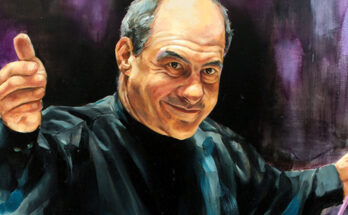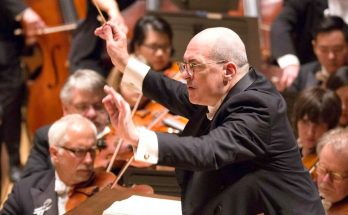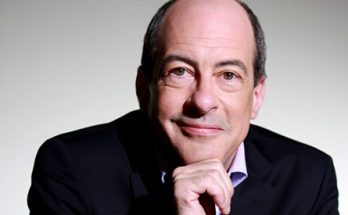“Sunrise” from Also sprach Zarathustra, Opus 30 (1896)
Richard Strauss was born in Munich, Germany, on June 11, 1864, and died in Garmisch-Partenkirchen, Germany, on September 8, 1949. The first performance of Also sprach Zarathustra took place in Frankfurt, Germany, on November 27, 1896, with the composer conducting the Museums-Orchester of Frankfurt-am-Main.
Strauss’s tone poem, Also sprach Zarathustra (Thus Spake Zarathustra) was inspired by Friedrich Nietzsche’s epic philosophic poem of the same name (1883-5). The protagonist in Nietzsche’s Zarathustra is based upon the ancient Persian prophet, also known as Zoroaster. In Thus Spake Zarathustra, the prophet leaves the solitude of his mountain refuge to share his wisdom with mankind.
Strauss was first drawn to Nietzsche’s masterwork during the composer’s preparations for his opera Guntrum (1894). He began composition of the score on February 4, 1896, and completed the work on August 24 of that year. The composer led the Museums-0rchester of Frankfurt-am-Main in the November 27, 1896 premiere.
This concert features the opening “Sunrise” from Also sprach Zarathustra, one of the most famous and spectacular moments in concert music (in program notes for the work’s premiere, Strauss described this section as follows: “Man feels the power of God”).
I. “Sunrise” — Over string bass tremolos, reinforced by the contrabassoon, organ and bass drum, the trumpets play a three-note ascending theme. The orchestra responds with fanfares and thunderous timpani attacks. This episode is twice repeated, proceeding to the glorious final statement.
Approximate performance time of “Sunrise” is two minutes.
Star Wars: Suite for Orchestra (1997)
George Lucas’s Star Wars films are among the most successful in the history of cinema. The riveting portrayals of adventures “a long time ago in a galaxy far, far away …” are the product of a remarkable collaboration of writing, acting, directing and production talent. No doubt one of the great reasons for the immense popularity of the Star Wars movies is the music written by the American composer and conductor, John Williams (born on February 8, 1932 in New York City).
The Williams’ Star Wars soundtracks, with their soaring melodies and brilliant orchestration, are among the finest achievements in American cinema, worthy of the tradition of such composers as Erich Wolfgang Korngold, Franz Waxman, and Bernard Herrmann.
As in the case of film scores written by John Williams’s great predecessors, excerpts from the Star Wars films have enjoyed immense popularity in the concert hall as well. This concert presents an orchestral Suite John Williams fashioned from his music for the first three Star Wars releases: Star Wars (1977), The Empire Strikes Back (1980), and Return of the Jedi (1983).
In a preface to the score, the composer offers the following comments:
During 1997 we celebrated the 20th anniversary of the release of George Lucas’ classic film Star Wars. All of us concerned with this phenomenal movie have been gratified to see an entire new generation of very young film-goers enjoy the Star Wars trilogy and relate so strongly to its story, characters, and music.
Also, I am personally delighted to have this new edition of the score available to orchestras and the public. It includes the “Imperial March” and “Yoda’s Theme,” both of which have not been available until this present printing.
I have always felt privileged to have had the opportunity to compose music for these landmark films, and the ongoing interest in the films and their music has continued to be one of my greatest joys.
— John Williams
Approximate performance time is twenty-five minutes.
The Planets, Suite for Large Orchestra (1916)
ASO Recording: Yoel Levi, Condutor (Telarc CD-80291)
Gustav Holst was born in Cheltenham, England, on September 21, 1874, and died in London, England, on May 25, 1934. The first performance of The Planets took place at Queen’s Hall in London on September 29, 1918, with Sir Adrian Boult conducting the New Queen’s Hall Orchestra.
Gustav Holst once remarked, “As a rule I only study things that suggest music to me.” And it was Holst’s lifelong interest in astrology that provided the inspiration for his most popular orchestral work, The Planets.
The Planets occupied Holst from the spring of 1914 to the winter of 1916. For the most part, Holst composed in a specially constructed soundproof room at the St. Paul’s Girls’ School, where he taught. During the course of his work on The Planets, Holst read a booklet by Alan Leo (What is a Horoscope?) that provided suggestions for the characteristics of the various planets.
Holst characterized his orchestral work as “a series of mood pictures” in which the movements — each representing a planet of the solar system — “acted as foils to one another.” The various movements were not arranged in accordance with the order of the planets in the solar system, but rather, in such a manner as to achieve optimal musical contrast and effect.
Although Holst completed The Planets toward the close of 1916, the onset of the First World War precluded a concert performance of the work. In the summer of 1918, Holst prepared to depart England to aid the war effort. As a special farewell gift, Henry Balfour Gardiner arranged for a private concert premiere of The Planets at Queen’s Hall in London on September 29, 1918. Holst chose the young Adrian Boult — later Sir Adrian — to conduct the first performance, which proved to be a great success.
The first public performance of The Planets took place on February 27, 1919, again with Boult conducting at Queen’s Hall (although Venus and Neptune were not played on that occasion). The Planets soon received numerous performances in England, Europe, and throughout the world. Along with Sir Edward Elgar’s Enigma Variations, The Planets — a thrilling sonic adventure, remains one of the most popular large-scale British orchestral works.
Approximate performance time is fifty-one minutes.
Musical Analysis
I. “Mars, the Bringer of War”; Allegro
While many believed that Holst created the opening movement as a memorial to the horrors of World War I, the composer insisted that “I had the whole of “Mars” fixed in my mind before” the August 4, 1914 Declaration. The movement begins softly, but ominously, with an incessant rhythm introduced by the timpani and col legno (“with the wood”; i.e., the string instruments play with the wood, rather than the horsehair portion of the bows) strings, and interjections by woodwind and brass. The music proceeds to a furious climax. Several brief episodes follow, all maintaining a relentless momentum to the shattering final bars.
II. “Venus, the Bringer of Peace”; Adagio
Venus offers blissful contrast to the violent opening movement. The solo horn’s ascending phrase is answered by a descending woodwind figure. A solo violin introduces the central Andante episode. A varied reprise of the opening Adagio concludes “Venus.”
III. “Mercury, the Winged Messenger”; Vivace
The third movement is a scherzo that exhibits a charm and grace reminiscent of Felix Mendelssohn’s Octet for Strings and Incidental Music to A Midsummer Night’s Dream. A 6/8 figure is deftly transferred from instrument to instrument. A middle section features lovely solo appearances by the violin, oboe, flute, and celeste. The return of the opening section (with a nod to its predecessor) concludes “Mercury.”
IV. “Jupiter, the Bringer of Jollity”; Allegro giocoso
Jupiter is the movement that most clearly reflects Holst’s affinity for British folk music. It opens with a flurry of activity in the violins and a bold orchestral statement. Several melodies follow, the most notable being an eloquent, andante maestoso theme, introduced by the strings and horns. This melody was later used as the basis for a patriotic hymn, “I Vow to Thee, My Country.” The bustle of the opening returns for the jubilant finish.
V. “Saturn, the Bringer of Old Age”; Adagio
The hypnotic opening features the flutes, bass flute, and harps. Over the repeated tread of pizzicato cellos and basses, the trombones introduce a somber march. The music builds to a powerful climax, featuring the repeated tolling of the bells. A reprise of the opening finally yields to a serene conclusion.
VI. Uranus, the Magician; Allegro
The trumpets and trombones, followed by the tubas and timpani, intone a four-note motif that will return throughout the movement. The bassoons then offer a puckish staccato figure, soon taken by the remainder of the orchestra. A solo bassoon and pizzicato cellos introduce a new theme, followed by a broader melody in the horns and strings. A prominent recapitulation of the four-note motif leads to a martial passage. A ffff climax is followed by an eerie postlude.
VII. “Neptune, the Mystic”; Andante
The composer directs that in the finale, “(t)he Orchestra is to play sempre pp throughout.” Various repeating figures, couched in orchestration of the utmost delicacy, masterfully evoke a sense of timelessness.
Star Wars and More plays Verizon Wireless Amphitheatre at Encore Park July 11.



